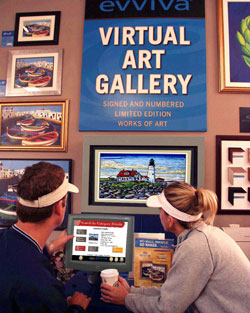Article
Virtual art shopping takes off at Home Depot specialty stores
There is little more personal than selecting the artwork to adorn a house or office. Consumers can spend weeks, even months searching for the perfect print to hang in a hallway. Or they can spend an hour or two at a kiosk. That is the promise of the Evviva Virtual Art Gallery in Expo Design Centers.
June 4, 2004
When someone selects a piece of art to display at home or in an office, it's an extremely personal choice. The perfect piece can tell visitors something about the tastes and style of the owner. Finding the right piece can take weeks or even months. A new alternative is to spend an hour or two at a kiosk.
That is the promise of the Evviva Virtual Art Gallery in Expo Design Centers in Dallas; Scottsdale, Ariz.; and Encinitas, Calif. Kiosks in these stores allow customers to peruse a virtual art gallery comprising an extensive database of artwork, select the size of the art, matte and framing. The customer can then print out a selection, bring it to a service desk and order the art for home delivery.
There are two kiosks deployed in each of the three Expo Design Centers, owned by Home Depot. The design centers specialize in home furnishings and major appliances. Shoppers at these stores are typically furnishing a new home or undertaking a home-improvement project.
Michael Bivins, president of Evviva, said he is talking with Home Depot about adding kiosks to more design centers - and also to Home Depot stores nationwide. There are about 55 Expo Design Centers and 1,500 Home Depot stores.
"We are still in the pilot stage, working mostly on in-store merchandising like where to locate units," said Bivins. He said the kiosks cost between $19,000 and $23,000, according to Bivins, who added that the price changes every day. Home Depot declined to talk about the pilot project, citing company policy on beta tests. The first kiosk was installed in November 2002, the second in February 2003 and the latest in April.
"We are there now indefinitely. Home Depot is happy with the project. Now it's up to them about when to expand the relationship," said Bivins. He said his company is also working with several other retailers "equally as significant as Home Depot."
Sylvia Berens, vice president of Apunix Computer Systems, said the application suits itself to any catalogued business. Apunix oversees the kiosk project for Evviva. Elo TouchSystems produces the touchscreens, and Pioneer Electronics provides the plasma screens for the systems. Lexmark provides the printers. Olea Exhibits designed the enclosures.
Two for the price...
What differen
 |
Customers making their art selection on Evvivva kiosk |
Gallery-quality art is the first item sold on the kiosk. The shopper uses the touchscreen to select the style of artwork based on parameters such as color, style, or subject matter. Another option is browsing the database of art in a random fashion or find works of art by particular artists.
The artwork is presented on the plasma screen with a frame and matte specially selected for that artwork by an art curator. Shoppers can make their own choices on the frame or matte selection and instantly see the new choices on the plasma screen. Once the shopper has decided on the right combination, he or she can print out a color sample of the framed artwork.
Taking inventory
The kiosks help retailers display an unlimited quantity of art. Because of space limitations, only a small selection of art is stocked at each store.
Evviva, which has experience in the art marketplace and running exclusive, high-end art galleries, now offers artwork by both famous and up-and-coming artists on the kiosks. Expo customers can purchase gallery-quality art at a fraction of the cost of a traditional gallery.
Bivins said that as more databases are added to the in-store server, more products will be offered in the same virtual format. One day, shoppers may be able to build a complete room scene from all items in the database.
Appliance power
The virtual art gallery represents one of the first deployments of the next generation of kiosk technology available from Apunix, Berens said. She said the application will be on display June 9-12, 2003, at Retail Systems in Chicago. "A demo is worth a million words," she said.
The two kiosk units are Apunix's Black Box thin-client kiosk appliance technology. The Apunix Black.Boxes boot and run from an industry standard CompactFlash memory chip. The CompactFlash memory chip contains a flash version of the Linux operating system. Added to this is a Java Virtual Machine in which runs Apunix's Kiosk Engine for the Java Platform.
The two Apunix Black.Box kiosks are connected to the first kiosk server appliance, a Sun Microsystems Cobalt Qube3. The Qube3 is the database server, content server, and gateway device for the kiosks.
Berens said the Qube can potentially serve up to a hundred kiosks, POS terminals and other devices in the store and can be remotely managed and updated from a chain's corporate headquarters using a secure web browser interface. Apunix is remotely managing the kiosks in the Evviva deployment.










